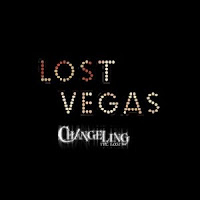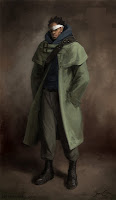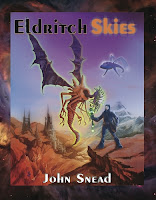A GUEST POST FROM MY WIFE SHERRI...
I fear drama.
I don't mean the extra-exclamation-points-to-make-my-life-seem-more-interesting-than-it-is
drama that floods the social media landscape. That'd be like being afraid of
professional wrestling or book clubs.
No, apparently I fear drama as a
game concept, specifically as a game concept finally possessed of cohesive and
workable mechanics thanks to Robin Laws and his DramaSystem. I can't get any
more specific about this fear—I just know the fear is there because I keep
trying to come up with reasons that the DramaSystem won't work at the table.
I know the signs of a knee-jerk reaction—the dismissal, the sneer, the desire to gather together the “everyone
else” who must certainly agree, the ever-so-convenient definition of a
“real” game that just happens to fit one's own safe place. And the number one
sign that some part of me is panicking: I simply have an incredibly difficult
time getting the nuances of how it works. I keep returning to the familiar
models, trying to shove DramaSystem onto them and saying, “See? See?! It's not
working.”
I'm smarter than that. I mean,
clearly I'm not BRAVER than that—but I'm smarter than that. My brainy brains,
however, are not half so good at pinning down why I vacillate between fight and
flight as they keep me just aware enough of my knee-jerkiness to feel great
shame.
This might not be a huge dilemma if
I lived in uncontested territory. I could ignore the scary idea that’s
out there, cling to the familiar and, if so inclined, shout out
passive-aggressively engineered insults to those who refuse to chain themselves
to the same rock. But the thing is, I’ve already tramped off into the
lands of narrative gaming, ignoring the shouts echoing from the valleys and
mountaintops “I’m only an expert on what I like, but that seems like gamism,”
“Player control is coddling!,” “Real gamers love TPKs,” “I own guns and that’s
not how they workkkkkkkkkkkkkk!”
I understand the shouts. I was
there once and sometimes I circle back. Some days I’ll give credibility
to the idea that what is familiar and habitual is ‘natural’—but I have learned
and relearned that other systems and mechanics quickly become just as familiar
and habitual. I like dice and complex mechanics and randomness deciding
the outcomes—it is fair, right? But I’ve played with newbies and realized
that my expertise gave me a huge advantage, and that the mechanics themselves
shaped the type and pace of the game. And simulationist thinking….gods, it
creeps back up on me all the freaking time. My brain knows all of that is
self-protective thinking—designed to maintain my sense of expertise and my
comfort and to enforce the level of trust I feel inclined to offer. I
KNOW this. Still, my knee gets a word in edgewise on occasion.
At least self-protective thinking
doesn’t slide by for long; I’m not alone in choosing my game path. My
husband is there too—and he’s thinking about games a lot harder than I am most
of the time. That’s good. He’s one of my GMs. I like
brilliant GMs. They can keep up with me and my brainy brains and my speedy
knee of ultimate jerkitude. And my husband, he is not about to let
me count myself out of the fun. I could pretend there’s some tough love
routine that goes on– but actually, he can pull me along pretty easily just by
dangling a game planning discussion in front of me.
In fact, it was a brainstorming
lunch that revealed to me the sheer bulk and dangerous nature of this invisible
new foe called DramaSystem. My husband was trying to come up with a
playable idea for a Christmas-themed DramaSystem Series Pitch. We met with
the agenda of just tossing some ideas out there. Brainstorming can be a
difficult dance—it’s about generating ideas with the critic turned off,
certainly, but there has to be at least a germ of a functional idea in
there. He started out with an ancient struggle to define the rituals that
would shape modern Christmas—my eyes glazed over; I recognized it was a BIG
idea but I couldn’t see the hook. That’s standard with brainstorming—lots
of themes with still-unarticulated handles for the PCs. I’m cool with
it.
We went back and forth a while—he’d
shake his head at my ideas: “Too procedural. There needs to be drama
between the player roles.” What? But I don’t get what’s going to
happen in any of his. They all sound concept-y but…not sure what you’d be
doing. Ok. Ok. Ummm. How about there’s a
time-travelling organization—but they can only insert themselves into a
time-frame on Christmas Eve and have to return before the end of Christmas
Day? I like this one. I’m expecting at least a nod. And
again, he says, "Too procedural. The game would center on the goals of
the time-travel, not on the drama between the players."
“So a Christmas soap opera?” I
wince when I hear the tone of voice that comes out in.
“Yes. No. Each player
has an agenda, things are happening—but the system is not focused on competencies
for completing those activities, it’s about negotiating advantage from the
outcome of those activities and negotiating which things are even undertaken.
It’s…”
“So…the player is not doing
…things?” My brain reeled—and that’s when the knee was free to grow in
power, in this instance like the Grinch’s heart expanding three sizes.
Now, the rest of the lunch I
remember primarily as a struggle to smile and somehow keep the knee under
control. I remember my husband realizing where I’d missed the point and
backtracking. He carefully spelled out the difference between resolution
systems (what I mistook DramaSystem for—just another narrative resolution
system) and a campaign framework. Essentially, while DramaSystem could be
bolted on to a procedural framework for the purposes of resolving negotiations,
it actually was designed specifically to allow campaigns that were about power
struggles and, well, drama—but character-driven drama as opposed to situational
drama. Instead of tension mounting as we fought wave after wave of
goblins and we finally feared for our lives as the last hit points were
reached, the tension would be about how we faced the goblins, what we chose to
defend most diligently from the goblins and how we negotiated with the goblins
if we couldn’t slaughter them -- all hard decisions made in order to preserve
what was important to us. It was Game
of Thrones as opposed to a monster-of-the-week show. And the
resolution system within Drama System could be used for social dynamics AND the
success of procedural actions as well.
My husband believes. He really
does. He’s ready to get started.
And I find that I tell myself I want
to preserve that procedural nature of the games. But really, deep down,
what I want to keep is my comfort level and my expertise and, most of all, the
cherished notion that I can deliver a win-win solution to any problem presented
in game if only I am clever enough.
With DramaSystem, I’d have to
choose.
Maybe that’s it.
Or maybe it’s that, with DramaSystem, I’d have to give up the last vestiges of my Mary Sue leanings.
Or maybe it’s that Drama like that
is my enemy at work—that I work constantly to defuse the emotional responses
and territorial behavior in order to define the actual project needs
requirements. Maybe Drama generated by what I perceive as
selfishness just happens to be the Enemy in so many parts of my life. I
like this explanation—it sounds semi-heroic.
Maybe it’s that the game table is
the one place where I can wrangle an illusion of consensus.
Maybe DramaSystem is a threat to
those all these things that I hold dear.
My knee thinks so.
My husband disagrees.
My brain is not helpful.
I predict an epic battle.



















